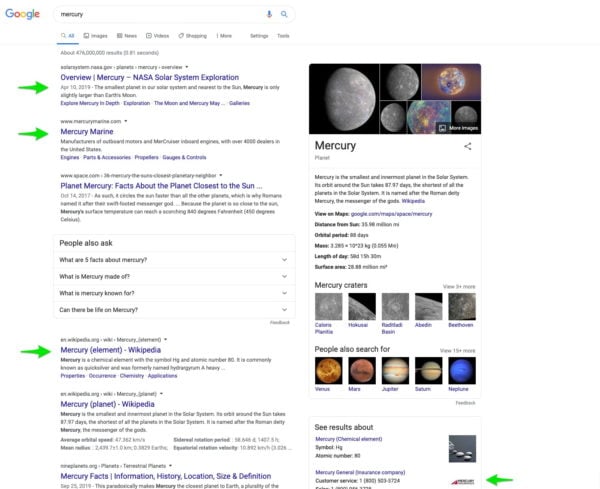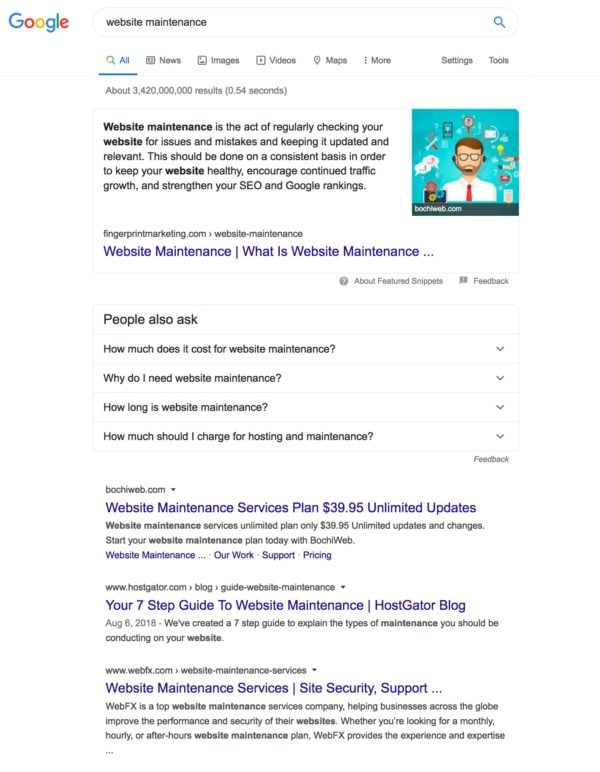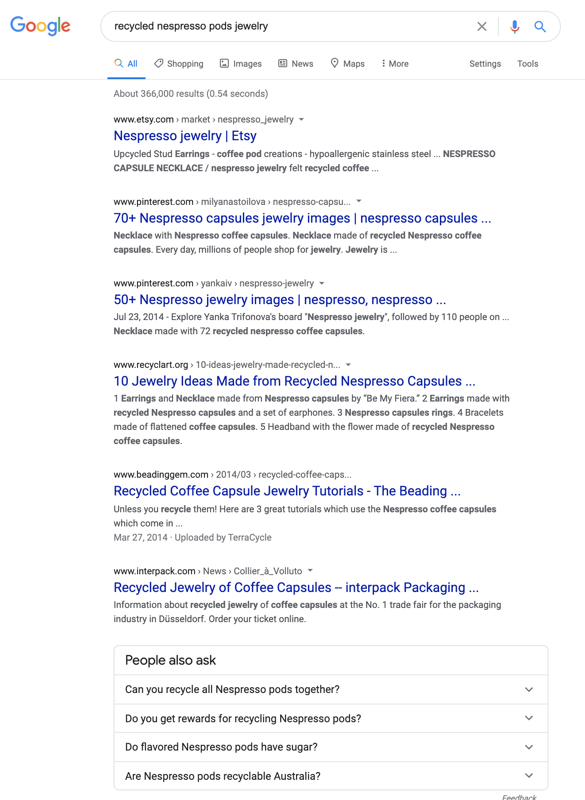To get your page to the top of the search results, you need to create content that people are actually looking for. That’s why you need to consider search intent before you start writing. Google is getting better and better at guessing what people want or need when they type in their – sometimes cryptic – search terms. So, creating great content means focusing on the search intent of your potential audience. But, what is search intent again? And how do you take it into consideration while creating your content? This post is all about that!
What is search intent?
Let’s start with a quick refresher on the term ‘search intent’. The easiest way to explain it is to think about your own online searches. Whenever you type in a search term you also have a particular intent in mind right? Sometimes, you just want to find some information. Other times, you’re looking to research or buy a certain product right away. And don’t forget those times you enter a brand name because you don’t want to type out the site’s entire URL. We generally distinguish four types of searcher intent: informational, commercial, transactional and navigational. If this is new to you, quickly head over to our SEO basics article on search intent, that’ll make understanding this post a bit easier.
Knowing what search intent your visitor has when it comes to their online search can help you create the content that they’re looking for. Great intent-based content that will increase the chance of them visiting your site, staying on your site and clicking through to your different pages. So, what do Google’s search results have to do with finding out more about the search intent of your audience?
Google tries to predict a user’s intent
Search engines, such as Google, use data to interpret what the dominant intent of a search is. They want to present results that match user intent exactly. And looking at these results can help you understand and match the search intent people have when searching for a certain keyword or keyphrase. Of course, within the four main categories of user intent, there can still be a lot of variation in what a user is exactly looking for. Before we can use the results to create great content that matches search intent, we need to understand how Google tries to determine someone’s search intent:
Search terms with one dominant intent
Sometimes, a search term has one dominant interpretation. Those terms can be very straightforward, like [buy King Louie Betty dress] or [symptoms of diabetes]. For the first term, Google will mainly show pages offering that particular model of dress for sale, or similar dresses by that brand. For the second search term, the results will be filled with answer boxes and sites offering medical information.
But it doesn’t end there, because Google also understands the search intent behind terms that aren’t as literal. For example, whenever people all over the world enter [white house] as a search term, Google will understand that they’re probably not looking for information on painting their house white. They want to know something about the residence of the president of the United States, and search engines show results accordingly.
Search terms referring to several entities
In many cases, people use the same term to look for very different things. For example, take the search term [Mercury]. Some people will be looking for the planet, others for the element, even others for the Roman god of commerce, and a few might be looking for the lead singer of the band Queen. This one word can be used to describe several distinctly different things – also described as entities. The context makes clear which entity a word is referring to. It’s important to be aware of how this works in search engines, so we wrote a post about entities and semantics that can help you with that.
All these searches for the term [Mercury] might have an informational intent, but they’re not looking for the same thing. While it’s difficult – especially with just one word – search engines still try to figure out what their users really want when typing in their search term. So, if fewer people click the ‘mercury-element’ results than the ‘mercury-planet’ results, search engines will deduce that more people want information about the planet Mercury, and alter the results pages accordingly. If we take a look at the search results for the term [Mercury], we’ll see that most results relate to the planet. From that, we can conclude that it’s the dominant intent: most people who type in this term are looking for the planet.

Search terms without dominant intent
Some search terms don’t have one clear-cut intent, which leaves search engines guessing at what to show. You can recognize these searches by the many different results shown on the results pages. Take the query [treehouse], for example. Depending on your location, the search results can show images of treehouses, information and videos on how to build one, advertisements for buying one, and businesses called ‘Treehouse’, including a brewery, restaurants, holiday homes, and a code learning web platform. This variety means that Google has most types of intent behind this query covered. But it may make ranking on this term more difficult.
So, how can the search results help you create great content?
Simply put: the search results give you a direct insight into what people are looking for when they type in your keywords. You can easily lose sight of the SERPs (Search Engine Results Pages) as your most direct source of information. But if you focus on your site alone, or only look at things through the eyes of online tools, you’re missing invaluable information about what your audience is looking for. Search results pages not only show you how you and your competitors are doing, but also where new opportunities lie and whether you need to adjust your SEO strategy. For instance, if you see a lot of informational content on a keyphrase that you’re trying to rank on with a very purchase orientated page, it might be a good idea to rethink the content on that page. Or if you see a lot of images in the results pages for your keyphrase, and you don’t have any, that’s another opportunity to improve your content!
To get the most objective idea of the search results for a query, make sure you use a private browser window. A local SERP-checker, such as valentin.app can also help you get more objective results, and find out what the results look like in other cities.
Creating great intent-based content yourself
There are a few steps you can take to attune your content better to user intent and work towards creating great content.
- Choose keywords from your keyword research and enter them in a private browser window or SERP-checker.
- Analyze what you see on the results pages. Which type of intent is most common (informational, commercial, etc)? Is there one dominant interpretation and if so, what is it? Do you see videos? Images? Related searches? Questions?
- Evaluate whether the content you have – or plan to publish – is in line with the content you found on the results pages. Do the types of intent match? Is your content in the right form?
- If yes, great! Perhaps you can find ranking ideas in related searches. And, have a quick peek at the competition, to see what you’re up against.
- Are you noticing that things don’t match up, and the SERPs show intent that doesn’t align with your content? If there isn’t a dominant type of intent, you might still be able to rank. However, if you find intent that unanimously doesn’t match what you have to offer at all -unless you have a high authority site- ranking will be difficult. If this is the case, consider whether it’s worth the effort to create or alter this content, or if you need to adjust your strategy a little. A solution could be to target a slightly different related keyword, with better matching user intent. Yoast SEO can help you find those related keyphrases that are being used by your audience and might be a better fit.
This might still sound a bit abstract. So, let’s look at a few examples to give you a better idea of this process in practice.
Examples of how to create content using the search results
Creating a post for our own blog
Here at Yoast, we write about all aspects of SEO. One of those aspects is keeping your website in good shape. We had an article planned on this topic, and one of the most important terms we used in this article was ‘Website maintenance’. Our article was about keeping your site content fresh and your site’s structure well-maintained in the process. However, when we started looking at the SERPs, we noticed that wasn’t what people were looking for at all when they used that term. The content in the answer box wasn’t really related, and the other results almost exclusively consisted of companies offering services to work on technical site maintenance and hosting, with some results stressing the importance of this.

So, from analyzing the SERPs, we got two important insights. Firstly, many people using the search term [website maintenance] have commercial intent, rather than informational. Secondly, they were actually looking for something completely different. So, while we could write an article about website maintenance to rank, it needed to be a completely different article. It should discuss things like hosting, technical site performance, etc, as that’s what searchers are looking for.
We realized we had to make changes to the article, adapt our strategy and target a keyword with better matching intent. We changed some of the wording in this article (and related ones as well) from ‘maintenance’ to ‘keep old content’, ‘update or delete’ and ‘cannibalization’. Of course, you could argue that we didn’t pick the right words here in the first place. The reason for that might’ve been that we got a bit stuck in our own content bubble, and forgot about the user. Looking at the SERPs helped change perspective in this case.
Another example: selling recycled jewelry
Let’s look at one more example, one that small business owners might relate to. Say, you run an online shop that sells jewelry made with recycled materials. One of your product groups is jewelry made of recycled nespresso pods. So, you’re thinking of trying to rank for [recycled nespresso pods] with a product page or category page. Is that a good idea? Time to look at the search results pages!
Of course, it somewhat depends on location, but prominent on the results page for [recycled nespresso pods] are results about how the pods are recycled. A few are from Nespresso itself, and you could also find some of their videos on recycling. Other results cover the process of recycling and how consumers can get their pods recycled. There is nothing on using recycled pods as a crafting material. So, now you know that this phrase will be difficult to rank for, as it’s not what users are looking for.

What about [recycled nespresso pods jewelry], then? As can be expected, the results align a lot better with what you have to offer. However, most results are geared towards informational intent. While the top result is Etsy -which would be difficult to compete with- other results show ideas and tutorials. This means, again, it would be hard to get your commercial or transactional product (category) pages on this list. However, you could still rank if you change your strategy and write a tutorial on crafting a basic piece of Nespresso jewelry. In such a tutorial, you could easily refer people to your products if they’re looking for more intricate pieces. Another way to find inspiration for your content is the ‘People also ask’ box in the search results. You can write content focused on answering these questions and refer to your products where this is fitting.
Conclusion
This post covers a lot of different aspects of search intent and how this can help you create great content. The exact steps to take will differ on a case to case basis. A good takeaway is to always have a good look at the results pages for keyphrases you’re targeting. Analyze what you see, as it’s valuable, first-hand information. Be realistic and be prepared to put in the work if you find you need to change your strategy. SEO is a lot of work, and you need to work hard to be the best result. But trust us, it will be worth it in the end!
Read more: On-SERP SEO: Maximize your brand’s visibility in the search results »
The post Using Google’s search results to create great content appeared first on Yoast.
from https://ift.tt/3dXsKFf



No comments:
Post a Comment